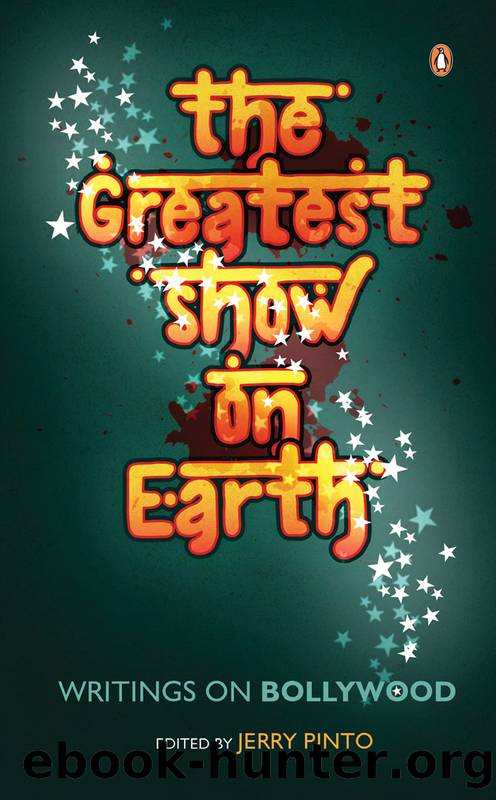The Greatest Show on Earth by Jerry Pinto

Author:Jerry Pinto [Pinto Jerry]
Language: eng
Format: epub
ISBN: 9789353052393
Publisher: Penguin Random House India Private Limited
Published: 2018-08-07T00:00:00+00:00
Sharaab nahin hoon magar ek nasha hoon
Main saare zamaane ke gham ki dawaa hoon.
(Alcohol I am not, but I am an intoxication
I am the cure of all the sorrows of the world.)
âLyrics from Helenâs song in
Adhikaar (1971)
I must have danced my way through more than a thousand films
in various languages, including Marwari and Bhojpuri.
âHelen, to Filmfare, on receiving a
Lifetime Achievement Award in 1998
With the exception of a few very silly films (Aap Beeti, Maya, Khoon Khoon, Jab Andhera Hota Hai), Helenâs name on the marquee meant that she was going to dance, which in turn generally meant a song. Not always, again, for there were some dances without songs as well (Hulchul, The Great Gambler). These sequences were primarily intended as eye candy but that was not the only function they performed.
The song in Hindi cinema has been paid much attention, most of it dismissive. It is regarded as a holdover from older art forms such as folk theatre and the Raas Leela and thus excused on the basis of its antiquity. It is scorned for its lack of realism, decried even by its exponents as ârunning around treesâ. However, a more reasonable way of looking at the song would be to see it as unreal in the rational senseâno hundred-piece orchestra plays when two people fall in love, nor can a woman walking through a cemetery be audible to everyone simultaneously in a huge mansionâbut certainly not meaningless in its symbolic reality.
Helenâs songs generally are described as cabarets. Historians of dance and other forms of public entertainment might cavil at the use of this term. For cabaret was born on 18 November 1881, when Rudolphe Salis opened his âChat Noirâ, a cabaret artistique, on Montmartre, Paris. His intention: âWe will satirize political events, enlighten mankind, confront it with its stupidity, cure those creeps of their ill-temper â¦â The original purpose of cabaret, therefore, was to shock the middle class (epater les bourgeois). It was more than a bunch of ladies showing off their frilly pantalettes or lack thereof. Skits were performed that lampooned authority; there were also other âactsâ, from contortionists to sword-swallowers to magicians. It was vaudeville with its underwear showing, a variety programme that teetered on the verge of being explicit, while never actually getting there. The frisson arose out of that unfulfilled promise.
Helen understood that. In The Britannica Encyclopaedia of Hindi Cinema, she says, â ⦠cabaret doesnât mean just wriggling your body as people thinkâitâs narration in dance. Paris nightclubs like Foleyâs and the Crazy Horse had these great cabarets.â Indeed, this was what she did in her best cabaretsâAa jaan-e-jaan from Intequam, Piya tu ab to aa ja from Caravan or Aaj ki raat koi aane ko hai from Anamikaâwhere a narrative is contained within the ambit of the song.
However, the word cabaret in the context of Indian cinema has come to mean a sexually suggestive dance performed by a woman for an audience that is either actually shown or is evident in the film.
Download
This site does not store any files on its server. We only index and link to content provided by other sites. Please contact the content providers to delete copyright contents if any and email us, we'll remove relevant links or contents immediately.
It's Only a Movie! by Haberski Jr. Raymond J(182)
The Garden in the Machine by Unknown(155)
Euro-Visions: Europe in Contemporary Cinema by Mariana Liz(150)
The Greatest Show on Earth by Jerry Pinto(147)
Jafar Panahi: Interviews by Unknown(138)
Film and the Nuclear Age by Toni A. Perrine(129)
The Fellowship of the Knits: Lord of the Rings: The Unofficial Knitting Book by Tanis Gray(123)
RKO Radio Pictures Horror, Science Fiction and Fantasy Films, 1929-1956 by Michael R. Pitts(108)
THE GOLDEN AGE OF EROTIC CINEMA: 1959-1972 by Wiilliam Rotsler(108)
Horror Film by Murray Leeder(106)
Offbeat (Revised & Updated) by Julian Upton;(92)
The Last Interview by Nora Ephron(89)
Chinese films in focus II by Unknown(87)
Tuitions and Intuitions by William Rothman;(85)
Red, Blue, and Bronze: Inside the Symbols of the Wonder Woman Film by Frankel Valerie Estelle(82)
June Allyson: Her Life and Career by Peter Shelley(82)
Last Stands from the Alamo to Benghazi by Frank Wetta Martin Novelli(79)
Horror Films FAQ: All That's Left to Know About Slashers, Vampires, Zombies, Aliens, and More by John Kenneth Muir(78)
The Essential Humphrey Bogart by Constantine Santas(78)
